Views of Tenant Farmers and Agricultural Landlords on Aspects of the Agricultural Tenancy System
Results from surveys of tenant farmers and agricultural landlords on aspects of the tenancy system such as rent review, fixed equipment, diversification and tenancy relationships.
1 INTRODUCTION
Background
1.1 Tenant farming accounts for more than one-third of all farmed land in Scotland[2], representing an important part of Scottish agriculture, with tenancies often providing a means of entry into farming. The continued decline in agricultural tenancies, alongside ongoing debate over the future of agricultural policy and regulation, has necessitated the need for better information on the tenant farming sector in Scotland to support policy and regulatory development.
1.2 The Scottish Government commissioned Ipsos MORI to carry out a telephone survey of tenant farmers and a complementary postal survey of agricultural landlords in Scotland. The aim of the research was to measure in detail specific aspects of the tenant-landlord relationship in the Scottish agricultural tenancy sector.
1.3 The survey primarily considered issues surrounding the functioning of tenancies of more than 1 year: the number and nature of tenancies rented-in/rented-out; the rent review process; fixed equipment; diversification; dispute resolution; and waygo.
1.4 The research will support the work of the Scottish Government Agricultural Holdings Legislation Review Group (AHLRG), and complements a number of surveys which have already been conducted: surveys of tenant farmers, agricultural landlords, and rural landowners who do not currently rent-out land. These previous surveys examined: the current level, nature and types of agricultural land tenure in Scotland; changes in land tenure since 2000; plans for the future of agricultural businesses; and views on the Absolute Right To Buy (ARTB).
Methodology
1.5 A telephone survey of a representative sample of tenant farmers and a complementary postal survey of agricultural landlords were conducted[3], with questionnaires designed to allow for the same issues to be investigated from the perspective of each audience.
1.6 Telephone fieldwork took place between 21st July and 7th August 2014. A total of 1,002 interviews were completed using Computer Assisted Telephone Interviewing (CATI). The sample was drawn from holdings in the Agricultural Census who reported renting-in land on a lease of one year or more, with quotas set in order to reflect the distribution of tenant farmers by regional location and farm type. Tenant farmers who only let land on a seasonal basis were not sampled, therefore all tenant farmers referred to in this report hold at least one lease of more than one year. A total of 5,581 tenant farms were called, giving a response rate of 18%. The questionnaire is provided in Annex 1.
1.7 Results of the survey of tenants farmers were weighted by regional location and type of farm according to the Agricultural Census.
1.8 Table 1.1 shows the unweighted and weighted number of tenant farmers by broad geographical area.
Table 1.1: Tenant farmers by region in Scotland
| North East | North West | South East | South West | |
|---|---|---|---|---|
| Unweighted total | 203 | 267 | 247 | 285 |
| Unweighted percentage | 20% | 27% | 25% | 28% |
| Weighted total | 190 | 294 | 224 | 294 |
| Weighted percentage | 19% | 29% | 22% | 29% |
1.9 Table 1.2 shows the spread of respondents by the type of farming that takes place on their agricultural tenancy.
Table 1.2: Tenant farmers by type of farm
| Arable | Livestock (LFA cattle and sheep) over 80 hectares |
Livestock (LFA cattle and sheep) under 80 hectares |
Mixed | Non-LFA cattle and sheep |
Other | |
|---|---|---|---|---|---|---|
| Unweighted total | 123 | 230 | 221 | 120 | 101 | 207 |
| Unweighted percentage | 12% | 23% | 22% | 11% | 10% | 24% |
| Weighted total | 120 | 210 | 220 | 110 | 100 | 240 |
| Weighted percentage | 12% | 21% | 22% | 11% | 10% | 24% |
1.10 A self-completion survey was sent by post to 2,400 landowners who rent-out agricultural land in Scotland. No full and accurate information is available on the population of agricultural landlords. Contact details were obtained from two sources: Single Application Form returns that identified farm business who seasonally let out land; and registrations for pre-emptive right to buy for a Secure 1991 Act tenancy. Hence, part of the sample for the survey of landlords was based on those who rent-out on a seasonal basis. The other part of the sample specifically targeted a sub-set of landowners with Secure tenancies.
1.11 Fieldwork took place between 9 July and 8 September 2014. Those who had not completed the survey were sent a postal reminder one month before the end of the fieldwork period, with another reminder sent out two weeks before fieldwork ended. The questionnaire is provided in Annex 2.
1.12 A total of 821 surveys were completed, giving an overall response rate of 34%. However, of these returns, only 299 landlords reported that they rent-out land on at least one lease of more than one year. A total of 151 questionnaires were returned as undeliverable or considered out of scope for some other reason such as the land was no longer being rented or the land had been sold.
1.13 It should be noted that, despite the return of 821 completed questionnaires, only between 83 and 380 valid responses were given for the majority of questions in the survey. There are two reasons for this. First, more than half of the returns reported that the landlord did not rent out any land on a lease of more than one year. One of the two elements making up the sampling frame for the landlord survey was businesses who reported renting-out land for less than one year through seasonal lets; this differs from the tenant farmer sampling frame which did not include any seasonal-only renters. Secondly, there was also some item non-response. This was because respondents answered only the questions they felt were relevant and/or of importance to themselves or because they did not know the specific details of their tenancy. The bases and percentages shown in the report exclude not stated/invalid responses. Occasions where 'not stated' responses were included have been footnoted in the report.
1.14 Readers should note that from Chapter 3 onwards when referring to landlord responses this will only include responses from those 299 landlords who reported having a lease or leases of more than one year.
1.15 As no full and accurate information is available on the population of agricultural landlords it is not possible to apply weighting to the results of this survey in order to proportionally reflect the actual profile of the Scottish agricultural landlords' population. There is, for example, no way of allocating a location or type to recipients. Similarly, it is difficult to estimate how much the survey has been affected by non-response bias.
1.16 The survey findings represent the views and information given by those tenant farmers and landlords who replied, and not the entire population, so they are subject to sampling tolerances, meaning that not all differences will be statistically significant. Throughout the report, differences between sub-groups are commented upon only where these are statistically significant, i.e. where we can be 95% certain that they have not occurred by chance. Results, particularly in the survey of landlords, may also be affected by non-response bias[4].
1.17 Where respondents have left a question blank, these have been excluded from the base. Where percentages do not sum to 100%, this may be due to rounding, the exclusion of 'don't know' categories in some analyses, or where multiple answers were allowed. Throughout the report, an asterisk (*) denotes any value of less than half a per cent. For questions where the number of respondents is less than 50, the number of times a response has been selected rather than the percentage is given, and an asterisk denotes a value of less than five responses.
Differences in responses between tenant farmers and landlords
1.18 It should firstly be noted that there was no linkage made between agricultural tenants and their landlords. So where in this report a contrast is made between the views of the two groups on a particular subject, we are not able to say that this is due to the two groups judging the same case differently. Rather, they are simply referring to different sets of tenancies.
1.19 Secondly, for several of the questions, respondents were asked to give answers relating to their largest lease. Assuming a structure where a landlord has many tenancies, the largest tenancy might very well be quite different in nature from the other tenancies. This would then result in justifiably different findings in the two surveys.
Profile of responding tenant farmers and agricultural landlords
1.20 One-third (33%) of tenant farmers who participated were in the 65 and over age group; 43% of tenant farmers were 50-64. Only 6% were under the age of 40 (Figure 1.1).
Figure 1.1: Tenant farmers age profile
Q. What age are you?
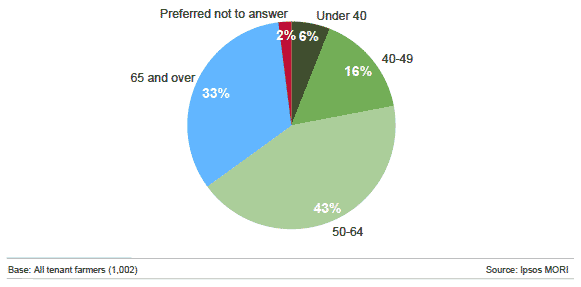
1.21 Half (50%) of tenant farmers reported that their family had farmed their main tenancy for 50-175 years, with a quarter having done so for 25-49 years and 14% for 10-24 years (Figure 1.2).
Figure 1.2: Tenant farmers' length of tenure on longest tenancy
Q. How long have you or your family farmed on your main tenancy?
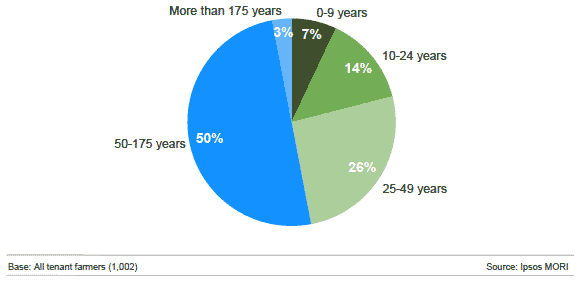
1.22 One-third (34%) of tenant farmers reported that all of their business is rented-in under a Secure 1991 Act tenancy with a further 16% reporting that more than half of their business is rented in under a Secure 1991 Act tenancy. Just under one-third (31%) reported that less than one-quarter of their business is under a Secure 1991 Act tenancy (Figure 1.3).
Figure 1.3: Proportion of tenant farmers' businesses rented-in under Secure 1991 Act tenancy[5]
Q. What proportion of your business is rented-in under a Secure 1991 tenancy?
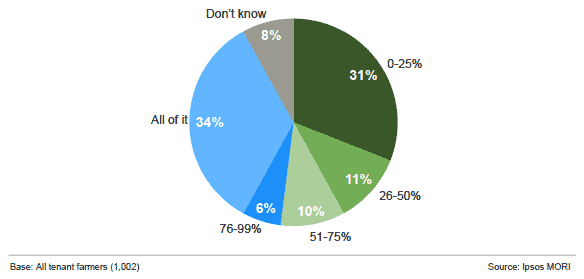
1.23 One-third (32%) of tenant farmers said that their total turnover in 2013 was more than £100,000, while a further 10% reported that their turnover was between £50-100,000 and 19% below £50,000. Around a third of tenant farmers said that they did not know their turnover for the previous year (Figure 1.4).
Figure 1.4: Tenant farmers' turnover in 2013
Q. What was your total turnover last year?
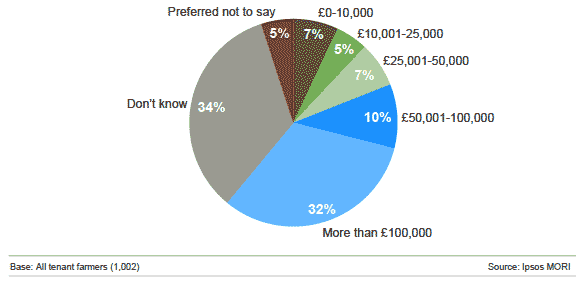
1.24 Among landlords, the survey was completed by the business owner or landlord in 41% of responses, while 13% of respondents were a business partner or trustee, 12% a spouse or family member, with a quarter (24%) of responses by estate managers or factors (Figure 1.5).
Figure 1.5: Landlords survey respondent profile
Q. Which of these best describes the person completing the survey?
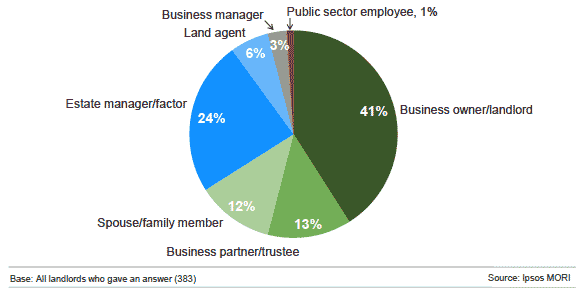
Contact
Email: Liz Hawkins
There is a problem
Thanks for your feedback